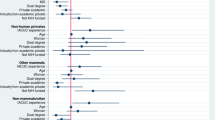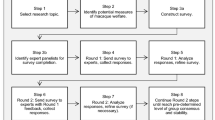Abstract
Nearly half of all external grants from the US National Institutes of Health require approval by the recipient organization's Institutional Animal Care and Use Committee (IACUC) before the funds can be used for research with animals. Given that large sums of money are spent annually on research involving animals, studies evaluating the strengths, weaknesses and overall effectiveness of IACUCs and similar animal welfare committees are needed. The authors designed and carried out a self-assessment survey on IACUC function and effectiveness. They found that 98% of all respondents believed that their IACUCs advanced animal welfare, but in many instances, veterinarians' responses to individual survey items were significantly different from those of other IACUC members. Protocol compliance, protocol review training and better understanding among non-committee members of the need for regulatory oversight are some areas where improvements could be made. Less than 50% of respondents stated that literature searches to find alternatives to animal use or painful or distressful procedures were helpful.
This is a preview of subscription content, access via your institution
Access options
Subscribe to this journal
We are sorry, but there is no personal subscription option available for your country.
Buy this article
- Purchase on Springer Link
- Instant access to full article PDF
Prices may be subject to local taxes which are calculated during checkout
Similar content being viewed by others
References
Hall, M. A critical and experimental essay on the circulation of the blood: especially as observed in the minute and capillary vessels of the batrachia and of fishes. (Carey, E.L. & Hart, A., Philadelphia, 1835).
Russell, W.M.S. & Burch, R.L. The Principles of Humane Experimental Technique (Methuen, London, 1959).
Silverman, J. Do pressure and prejudice influence the IACUC? Lab Anim. (NY) 26, 23–25 (1997).
Plous, S. & Herzog, H. Animal research. Reliability of protocol reviews for animal research. Science 293, 608–609 (2001).
US Department of Agriculture. USDA Employee Survey on the Effectiveness of IACUC Regulations (blisher: USDA, Riverdale, MD, 2000). <http://www.aphis.usda.gov/animal_welfare/downloads/iacuc/iacucaugust.pdf>
Graham, K. A study of three IACUCs and their views of scientific merit and alternatives. J. Appl. Anim. Welf. Sci. 5, 75–81 (2002).
Hawkins, P. Recognizing and assessing pain, suffering and distress in laboratory animals: a survey of current practice in the UK with recommendations. Lab. Anim. 36, 378–395 (2002).
Schuppli, C.A. & Fraser, D. Factors influencing the effectiveness of research ethics committees. J. Med. Ethics 33, 294–301 (2007).
Gomez, L.M., Conlee, K.M. & Stephens, M.L. Noncompliance with Public Health Service (PHS) policy on humane care and use of laboratory animals: an exploratory analysis. J. Appl. Anim. Welf. Sci. 13, 123–136 (2010).
Animal Welfare Act. Public Law 89-544. Title 7 §2131 et seq.
Health Research Extension Act of 1985. Public Law 99-158. (20 November 1985).
Code of Federal Regulations, Title 9, Chapter 1, Subchapter A, Parts 1–3.
Public Health Service. Policy on the Humane Care and Use of Laboratory Animals (US Department of Health and Human Services, Washington, DC, 1986; amended 2002).
Galvin, S.L. & Herzog, H.A. The ethical judgment of animal research. Ethics Behav. 2, 263–286 (1992).
Karas, A. & Silverman, J. in The IACUC Handbook 2nd edn. (eds. Silverman, J. Suckow, M.A. & Murthy, S.) 241–286 (CRC, Boca Raton, FL, 2007).
Plous, S. Attitudes toward the use of animals in psychological research and education: Results from a national survey of psychologists. Am. Psychol. 51, 1167–1180 (1996).
Plous, S. Attitudes toward the use of animals in psychological research and education: Results from a national survey of psychology majors. Psychol. Sci. 7, 352–358 (1996).
National Science Board Science and Engineering Indicators 2002 (NSB-02-01A) (National Science Foundation, Arlington, VA, 2002).
National Science Board. Science and Engineering Indicators 2008 (NSB 08-01; NSB 08-01A) (National Science Foundation, Arlington, VA, 2008).
Dresser, R. Review standards for animal research: A closer look. ILAR J. 32, 2–7 (1990).
USDA APHIS AC. Animal Care Policy #12. Consideration of Alternatives to Painful/Distressful Procedures (21 June 2000). <http://www.aphis.usda.gov/animal_welfare/policy.php?policy=12>
US Department of Agriculture, Office of Inspector General Western Region. Audit Report: APHIS Animal Care Program Inspection and Enforcement Activities (Report No. 33002-3-SF) (2005).
Brown, P. & Gipson, C. Noncompliance in survival surgery technique: a word from OLAW and USDA. Lab Anim. (NY) 39, 234 (2010).
Keith-Spiegel, P. & Koocher, G.P. The IRB paradox: could the protectors also encourage deceit? Ethics Behav. 15, 339–349 (2005).
Goffee, R. & Jones, G. Leading clever people. Harvard Business Review 85, 72–79 (2007).
Gouldner, A.W. Patterns of Industrial Bureaucracy (Free Press, 1964).
Stephenson, W. Deficiencies in the National Institutes of Health's guidelines for the care and protection of laboratory animals. J. Med. Philos. 38, 375–388 (1993).
Tallman, W.T. RE: Proposed Adoption and Implementation of the Eighth Edition of the Guide for the Care and Use of Laboratory Animals [FR Doc. 2011–4172] (letter to Dr. Patricia Brown). FASEB (2011). <http://www.faseb.org/LinkClick.aspx?fileticket=AZb%2F%2F57PrdI%3D&tabid=198>
Institute for Laboratory Animal Research. Guide for the Care and Use of Laboratory Animals 8th edn. (National Academies Press, Washington, DC, 2011).
Association for Assessment and Accreditation of Laboratory Animal Care International About AAALAC: Council on Accreditation (2012). <http://www.aaalac.org/about/council.cfm>
American Association for Laboratory Animal Science. Performance-based criteria as the basis for determining laboratory animal housing standards. <http://www.aalas.org/association/position_statements.aspx>
Steneck, N.H. Role of institutional animal care and use committees in monitoring research. Ethics Behav. 7, 173–184 (1997).
Häyry, H. Should the decisions of ethics committees be based on community values? Med. Health Care Philos. 1, 57–60 (1998).
Gluck, J.P. & Orlans, F.B. Institutional animal care and use committees: a flawed paradigm or work in progress? Ethics Behav. 7, 329–336 (1997).
Stafleu, F.R., Grommers, F.J. & Vorstenbosch, J. Animal welfare: Evolution and erosion of a moral concept. Anim. Welf. 5, 225–234 (1996).
Houde, L., Dumas, C. & Leroux, T. Animal ethical evaluation: an observational study of Canadian IACUCs. Ethics Behav. 13, 333–350 (2003).
Orlans, F.B. Ethical decision making about animal experiments. Ethics Behav. 7, 163–171 (1997).
Acknowledgements
We thank Sally Gore for carrying out the database searches for alternatives to animal use or painful or distressful procedures and Molly Greene and Christopher Lyons for their help in determining the number of mailing list name duplications.
Author information
Authors and Affiliations
Corresponding author
Ethics declarations
Competing interests
The authors declare no competing financial interests.
Rights and permissions
About this article
Cite this article
Silverman, J., Baker, S. & Lidz, C. A self-assessment survey of the Institutional Animal Care and Use Committee, Part 1: animal welfare and protocol compliance. Lab Anim 41, 230–235 (2012). https://doi.org/10.1038/laban0812-230
Received:
Accepted:
Published:
Issue Date:
DOI: https://doi.org/10.1038/laban0812-230
This article is cited by
-
The role of the IACUC in ensuring research reproducibility
Lab Animal (2017)
-
Policy pressure from the Institutional Official
Lab Animal (2014)
-
IL-25 Promotes Th2 Immunity Responses in Airway Inflammation of Asthmatic Mice via Activation of Dendritic Cells
Inflammation (2014)
-
Erratum: A self-assessment survey of the Institutional Animal Care and Use Committee, Part 1: animal welfare and protocol compliance
Lab Animal (2012)
-
A self-assessment survey of the Institutional Animal Care and Use Committee, Part 2: structure and organizational functions
Lab Animal (2012)



